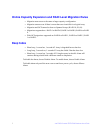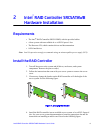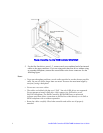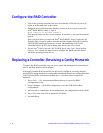Intel® RAID Controller SRCSATAWB Hardware User’s Guide 2
Operating System Support
• Windows Server 2003*, Windows 2000* Enterprise Server, SP4 and Windows XP*.
• Red Hat* Enterprise Linux 3.0 and 4.0.
• SuSE* Linux Enterprise Server 9, SP1-3 and SLES 10.
The operating systems supported may not be supported by your server board. See the
tested operating system list for your server board at
http://support.intel.com/support/motherboards/server/. See also the tested hardware and
operating system list for the RAID Controller SRCSATAWB to make sure the RAID card
supports your operating system.
Usability
• The card ships with both a standard and a low-profile bracket.
• Small, thin cabling with serial point-to-point 3.0 Gbps data transfer rates.
• Support for non-disk devices and mixed capacity drives.
• Support for intelligent XOR RAID levels 0, 1, 5, 6, 10, 50, and 60.
• Dedicated or global hot spare with auto rebuild if an array drive fails.
• User defined stripe size per drive: 8, 16, 32, 64 (def), 128, 256, 512 KB or 1 GB.
• Advanced Array configuration and Management Utilities provides:
— Online Capacity Expansion (OCE) adds space to existing drive or new drive.
See Appendix A for limitations on OCE and RAID migration.
— Online RAID level migration (upgrade of RAID mode, may require OCE).
— Drive migration.
— Drive roaming.
— No reboot necessary after expansion.
• Upgradeable Flash ROM interface.
• Allows for staggered spin up, hot-plug, and lower power consumption.
• User specified rebuild rate (percent of system resources to use from 0-100%).
Caution: Exceeding 50% rate may cause operating system errors due to waiting for
controller access.
• Background operating mode can be set for Rebuilds, Consistency Checks,
Initialization (auto restarting Consistency Check on redundant volumes); Migration,
OCE, and Patrol Read.


















